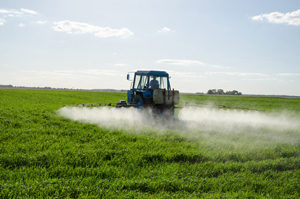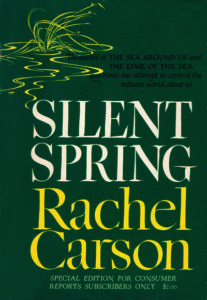 Rachel Carson’s ground-breaking, environmental message in Silent Spring appeared nearly 56 years ago. A number of the concerns that confronted her in 1962 still exist. They compel us to keep working for her goals. Two recent publications, described below, relate to Carson’s message in Silent Spring and in “A New Chapter to Silent Spring.” They are followed by RCLA’s Comments and Actions, we all can take to become healthier citizens within a more sustainable environment.
Rachel Carson’s ground-breaking, environmental message in Silent Spring appeared nearly 56 years ago. A number of the concerns that confronted her in 1962 still exist. They compel us to keep working for her goals. Two recent publications, described below, relate to Carson’s message in Silent Spring and in “A New Chapter to Silent Spring.” They are followed by RCLA’s Comments and Actions, we all can take to become healthier citizens within a more sustainable environment.
Reduced Occurrence of Cancer With An Organic Diet
A scientific study by J. Baudry et al. “Association of Frequency of Organic Food Consumption and Cancer,” published in JAMA Internal Medicine a peer-reviewed journal on October 22, 2018 was paid for entirely with government and public funds. It addresses Rachel Carson’s concerns about the relationship between pesticides and cancer (Silent Spring, Chapter 14). The Baudry article “strongly suggests that an organic based diet could contribute to reducing cancer risks.” The authors conclude that, “promoting organic food consumption in the general population could be a promising preventive strategy against cancer.” A report appearing in The New York Times, 10-30-18 by Robin Caryn Rabin, “Eyeing Organic Food As Cancer Foe” that features the Baudry article asserts that for the study’s subjects (the majority of whom were women): “The most frequent consumers of organic food had 76% fewer lymphomas, with 86% fewer non-Hodgkin’s lymphomas, and a 34% reduction in breast cancers that develop after menopause.”
A Better Way of Pest Control For Agriculture
The 2017 (432 page) book, Environmental Pest Management: Challenges for Agronomists, Ecologists, Economists and Policymakers, edited by Moshe Coll & Eric Wajnberg focuses on current methods of pest control.
This scholarly text with an international list of contributors is a “wide-ranging, interdisciplinary exploration of key topics that interrelate pest management, public health and the environment.” The book’s conclusions reflect Rachel Carson’s warnings about the hazards of chemical pesticides and the advantages of biological pest management methods. They reinforce the timeliness of Silent Spring’s “The Other Road.” (Footnote #1)
In Environmental Pest Management, editors Coll & Wajnberg recommend replacement of the present conventional/calendar, chemical pesticide applications (Footnote #2) with a sustainable IPM-based strategy. (Footnote #3)
What’s Wrong With the Present Agricultural Use of Chemical Pesticides?
“…the negative effects of pesticide use on human health and the environment are a burden to society,” (p. 412, eds. Coll & Wajnberg, Environmental Pest Management: Challenges for Agronomists, Ecologists, Economists and Policymakers, 2017)
“In the vast majority of cropland around the world pests are currently controlled chemically with little consideration of human and environmental health.” (p. 414, Coll & Wajnberg)
Despite the widespread use of chemical pesticides in the form of calendar spraying (Footnote #2) the authors note that: “…we have failed to reduce yield losses to pests and to produce more food in sustainable and environmentally compatible ways… Global crop losses to arthropods, diseases and weeds increased from 34.9% in 1965 to 42.1% in 1990 despite continuous intensification of pest control efforts.” (p. 407, Coll & Wajnberg). (Footnote #4)
What Could Replace The Present Agricultural Method of Pest Control?
Coll & Wajnberg advocate “a new framework for the development of effective, sustainable and environmentally compatible pest management” to replace calendar spraying of chemical pesticides. They call it a sustainable system of Integrated Pest Management (IPM). This could significantly reduce or eliminate the agricultural use of chemical pesticides and increase farmers’ reliance on alternative forms of pest management, including biologicals.
Where Is This Recommended “Sustainable IPM” Used?
Sustainable IPM is “employed globally, mostly in organic farming systems, which occupy an extremely small [but rapidly increasing] proportion of the total arable land in the world.” (p. 414, Coll & Wajnberg) Note: Current IPM strategies include recently developed biological pest control methods as well as those previously in use.
What US Policies Have Resulted in Widespread Calendar Pesticide Spraying?
Coll & Wajnberg indicate that reliance on calendar spraying of pesticides in the USA came about partly due to the withdrawal of government support of agricultural extension services and the replacement of support for such services by industry sources.
A recent survey “indicates that 81% of responding extension officers in the USA are in a partnership with industry.” (p. 413, Coll & Wajnberg)
What Policy Steps Can Help Lead to Sustainable IPM Pest Management?
Governments need to give enhanced value to the health of humans and the environment in conjunction with agricultural practices
Extension service agents need to be trained in alternative (non-chemical) methods of controlling agricultural pests. Support of the extension service needs to come primarily through government funding.
A system needs to be established by government regulations requiring compensation (to be paid by pesticide users) to society for the risks and costs to human health and the environment of hazardous chemical pesticide applications.
RCLA Comment:
Costs of the widespread agricultural applications of chemical pesticides that are borne by society include immediate and long term human health adverse effects. Chronic health conditions associated with chemical pesticides include cancer, Parkinson’s disease and other neurological conditions as well as endocrine and developmental disorders. Recently, the advisability of replacing our chemical-based agriculture with an organic-type growing system was reinforced by the Baudry, et., al., study. “Association of Frequency of Organic Food Consumption and Cancer.” In a review of the study’s results it was reported that the most frequent consumers of organic food had fewer lymphomas, fewer non-Hodgkin’s lymphomas and (for the women) a reduction in breast cancers that develop after menopause.” (Rabin, R.C., “Eyeing organic food as cancer foe,” The NYT, 10-30-18) These findings strongly suggest that “an organic based diet could contribute to reducing cancer risks.” (Baudry, et al., JAMA Internal Medicine, 10-22-18)
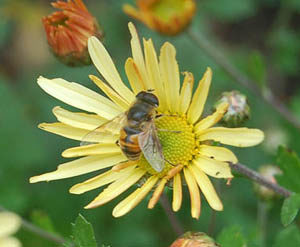 Agricultural use of hazardous chemical pesticides can lead to decreasing biodiversity, loss of valuable wildlife, and contamination of essential habitats. Our current chemically-dependant system of growing food and fiber presents environmental hazards to bees, beneficial insects, plants, soil, water bodies, aquatic invertebrates, birds, amphibians, fish, and marine mammals. The ecologist, Dr. Chuck Benbrook has observed: “In the real world of pesticide regulation birds, fish and bees are expendable.”
Agricultural use of hazardous chemical pesticides can lead to decreasing biodiversity, loss of valuable wildlife, and contamination of essential habitats. Our current chemically-dependant system of growing food and fiber presents environmental hazards to bees, beneficial insects, plants, soil, water bodies, aquatic invertebrates, birds, amphibians, fish, and marine mammals. The ecologist, Dr. Chuck Benbrook has observed: “In the real world of pesticide regulation birds, fish and bees are expendable.”
The loss of essential insects in addition to other wild species that can be linked in part to present-day agricultural methods, requires giving the highest priority to switching away from using chemical pesticides to an organic or sustainable, ecological, IPM-type growing strategy.
Organic farming practices using sustainable ecological IPM methods are advocated by Coll & Wajnberg in their book, Environmental Pest Management: Challenges for Agronomists, Ecologists, Economists and Policymakers
Organic-type growing conditions result in soil with a greater capacity to sequester carbon and to retain water giving the soil an enhanced ability to withstand drought conditions. Reliance on biological pest control under organic/sustainable IPM farming practices can reduce the need for fossil fuel based chemicals. Soils not regularly treated with broad spectrum pesticides can have greater numbers of living organisms contributing to the soils’ fertility and natural disease resistance.
Part of the reason that the US agriculture has come to depend on chemical pesticides lies in the historical trend for the federal government to decrease funding of extension services and to reduce the support of research on biological controls. This governmental decline in support has been replaced over the years by support from industrial sources. A recent survey “indicates that 81% of responding extension officers in the USA are in a partnership with industry.” (p. 413, Coll & Wajnberg)
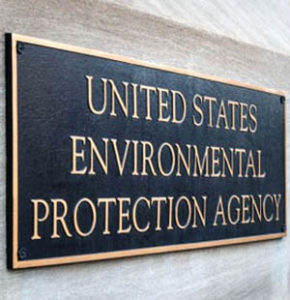 In “A New Chapter to Silent Spring,” Rachel Carson wrote: “we must insist that the burden of proof is on those who would use these chemicals to prove the procedures are safe.” (May 1963, Bulletin of the Garden Club of America). This is not the present US policy with respect to chemical pesticides. Pesticides are registered by the USEPA under a risk/benefit standard. The USEPA does not allow applicators of registered pesticides to call chemical pesticides “safe.” Governments need to promote existing organic growing practices as safer alternatives especially with respect to the most hazardous chemicals.
In “A New Chapter to Silent Spring,” Rachel Carson wrote: “we must insist that the burden of proof is on those who would use these chemicals to prove the procedures are safe.” (May 1963, Bulletin of the Garden Club of America). This is not the present US policy with respect to chemical pesticides. Pesticides are registered by the USEPA under a risk/benefit standard. The USEPA does not allow applicators of registered pesticides to call chemical pesticides “safe.” Governments need to promote existing organic growing practices as safer alternatives especially with respect to the most hazardous chemicals.
Governments need to give a higher priority to human and environmental health with respect to agricultural practices. We agree with editors, Coll & Wajnberg who recommend a greater government role in supporting research on new biological pest controls and higher levels of funding for extension service agents’ training in organic and sustainable IPM methods.
Helpful Actions We All Can Take
Individuals need to buy organic food and fiber products in support of sustainable IPM-type agriculture. This could improve our own health and help preserve habitat that is safe for beneficial wildlife. Note: This includes purchase of bird-friendly organic coffee.
Citizens can also support the adoption of sustainable methods for growing grass under legislation similar to that passed in Montgomery County, Maryland as the Healthy Lawns Act (Bill 52-14). Such legislation would eliminate applications of hazardous chemicals for cosmetic reasons on turf located on private property.
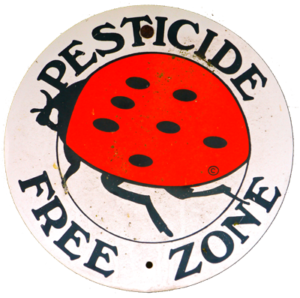 Home owners can put signage on their properties indicating that chemical pesticides are not applied to the premises.
Home owners can put signage on their properties indicating that chemical pesticides are not applied to the premises.
Whole neighborhoods can become bee & beneficial insect sanctuaries where no hazardous pesticides are sprayed, routinely.
Garden clubs can adopt guidelines for organic growing of vegetables and ornamentals that help to restore insect populations. Recent reports about significant declines in insect populations in Germany and parts of the US provide a strong motivation for not using any chemical pesticides (insecticides, herbicides and fungicides) on lawns and gardens. (Guarino, B., The Wash Post, 10-15-18)
Another reason why greater efforts should be made to encourage communities to eliminate pesticide spraying is that these chemicals can drift from the intended site and adversely impact adjacent properties.
Please help us get this information out to the public by supporting RCLA with a generous donation.
This is important!
Diana Post for RCLA, 11-7-18
Footnotes
Footnote #1) Silent Spring’s Chapter 17, “The Other Road” focused on biological ways of controlling pest insects, including releasing sterile males of the screwworm fly pest to mate with normal females thereby effectively preventing the next generation of this serious scourge. This process was developed by a researcher at the USDA, featured in Silent Spring, included in the 1963 CBS Reports TV program, “The Silent Spring of Rachel Carson” and is still in use today. It is considered the most successful of any strategy (including chemical) for controlling a major insect pest of the Americas. Its effectiveness — 100% elimination of the screwworm fly population being treated — shows what can be accomplished when government research focuses on alternatives to chemical pesticides. Chapter 17, “The Other Road” also highlighted biological control of insect pests by beneficial insects, bacteria, fungi, and rodents in the course of carrying out their daily activities within their natural habitats. These are examples of what today we call ecosystem services.
Footnote #2) An example of calendar spraying of pesticides is applying insecticides on a predetermined date whether or not the target pests (aphids, borers, etc.) are present. The term can refer to herbicides and fungicides as well.
Footnote #3) Editors Coll & Wajnberg favor a definition for IPM similar to the one from University of California Statewide IPM Program (U of CA Agriculture and Natural Resources 2016) appearing below with additional knowledge-based aspects.
“Integrated Pest Management is an ecosystem-based strategy that focuses on long term prevention of pests or their damage through a combination of techniques such as biological control, habitat manipulation, and modification of cultural practices. Pesticides are used only after monitoring indicates they are needed, and pest control materials are selected and applied in a manner that minimizes risks to humans, non-target organisms, and the environment.” (p. 378. Coll & Wajnberg)
Sustainable IPM is knowledge intensive, calling for an in depth ecological understanding of agro-ecosystems, their food webs and species interactions. Other elements for sustainable IPM include a government commitment as well as considerations of public health, conservation, economics, and consumer interests.
“IPM programmes rely on know-how…implemented through governmental extension services, [and] farmer participatory research…” (p. 10, Coll & Wajnberg) For best result the support needs to come from public sources.
Footnote #4) In “A New Chapter to Silent Spring” Carson stated: “During the first half of this century, crop loss due to insect attack has been estimated by a leading entomologist at 10% a year. It is startling to find, then, that the National Academy of Science last year [1962] placed the present crop loss at 25% per year. If the percentage of crop loss is increasing at this rate, even as the use of modern insecticides increases, surely something is wrong with the methods used!” (May 1963, Bulletin of the Garden Club of America)


